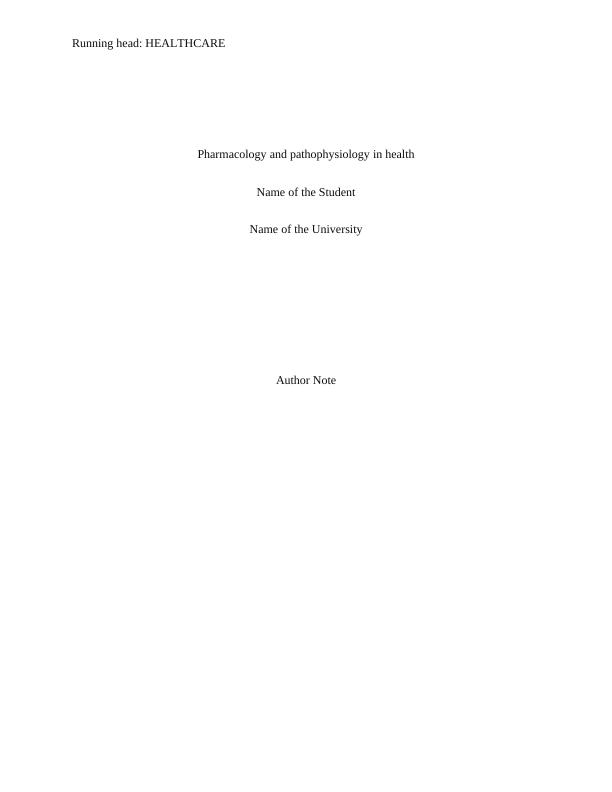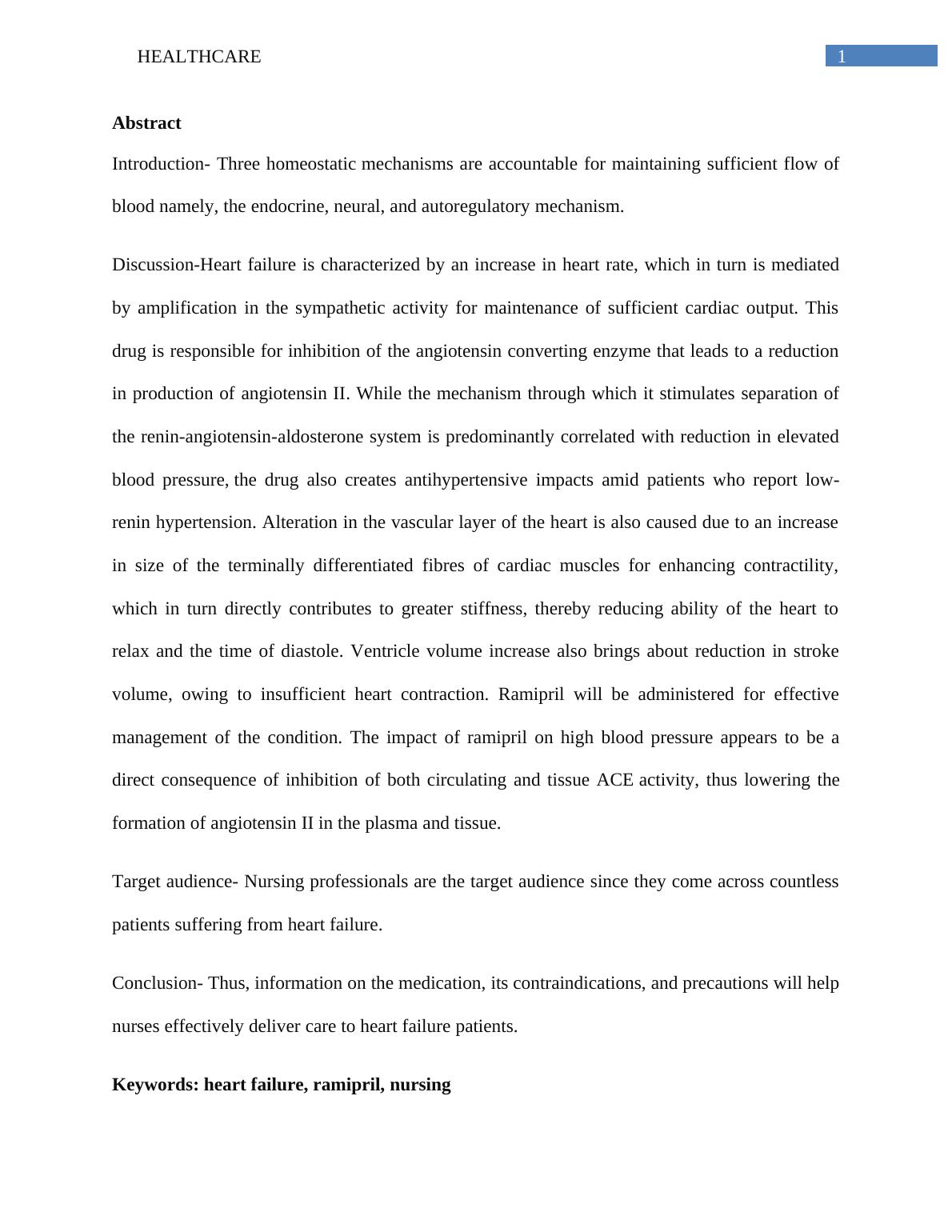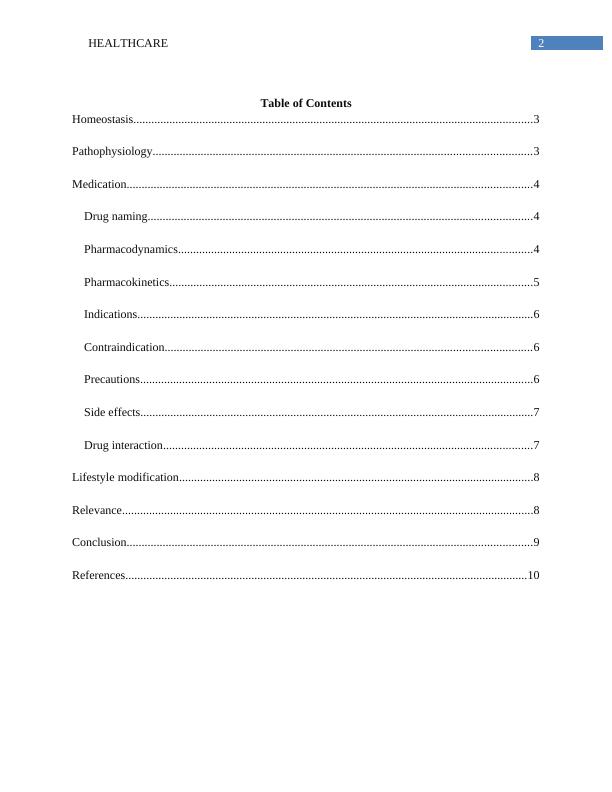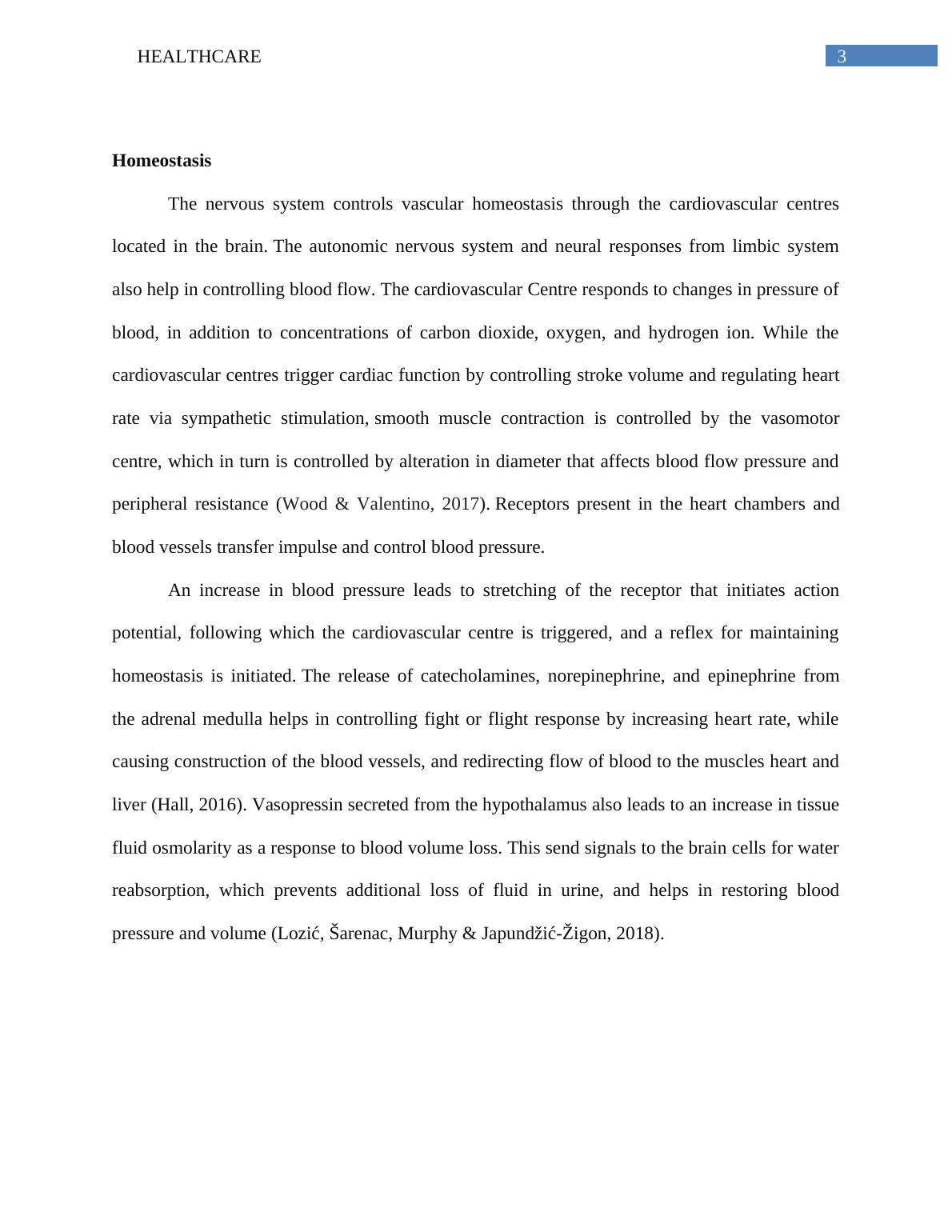Neuroscience & Biobehavioral Reviews
Produce an informative article that describes the pathophysiology of a specific disease or condition, as well as present the pharmacology used to address this.
13 Pages2755 Words14 Views
Added on 2022-08-23
Neuroscience & Biobehavioral Reviews
Produce an informative article that describes the pathophysiology of a specific disease or condition, as well as present the pharmacology used to address this.
Added on 2022-08-23
ShareRelated Documents
Running head: HEALTHCARE
Pharmacology and pathophysiology in health
Name of the Student
Name of the University
Author Note
Pharmacology and pathophysiology in health
Name of the Student
Name of the University
Author Note

1HEALTHCARE
Abstract
Introduction- Three homeostatic mechanisms are accountable for maintaining sufficient flow of
blood namely, the endocrine, neural, and autoregulatory mechanism.
Discussion-Heart failure is characterized by an increase in heart rate, which in turn is mediated
by amplification in the sympathetic activity for maintenance of sufficient cardiac output. This
drug is responsible for inhibition of the angiotensin converting enzyme that leads to a reduction
in production of angiotensin II. While the mechanism through which it stimulates separation of
the renin-angiotensin-aldosterone system is predominantly correlated with reduction in elevated
blood pressure, the drug also creates antihypertensive impacts amid patients who report low-
renin hypertension. Alteration in the vascular layer of the heart is also caused due to an increase
in size of the terminally differentiated fibres of cardiac muscles for enhancing contractility,
which in turn directly contributes to greater stiffness, thereby reducing ability of the heart to
relax and the time of diastole. Ventricle volume increase also brings about reduction in stroke
volume, owing to insufficient heart contraction. Ramipril will be administered for effective
management of the condition. The impact of ramipril on high blood pressure appears to be a
direct consequence of inhibition of both circulating and tissue ACE activity, thus lowering the
formation of angiotensin II in the plasma and tissue.
Target audience- Nursing professionals are the target audience since they come across countless
patients suffering from heart failure.
Conclusion- Thus, information on the medication, its contraindications, and precautions will help
nurses effectively deliver care to heart failure patients.
Keywords: heart failure, ramipril, nursing
Abstract
Introduction- Three homeostatic mechanisms are accountable for maintaining sufficient flow of
blood namely, the endocrine, neural, and autoregulatory mechanism.
Discussion-Heart failure is characterized by an increase in heart rate, which in turn is mediated
by amplification in the sympathetic activity for maintenance of sufficient cardiac output. This
drug is responsible for inhibition of the angiotensin converting enzyme that leads to a reduction
in production of angiotensin II. While the mechanism through which it stimulates separation of
the renin-angiotensin-aldosterone system is predominantly correlated with reduction in elevated
blood pressure, the drug also creates antihypertensive impacts amid patients who report low-
renin hypertension. Alteration in the vascular layer of the heart is also caused due to an increase
in size of the terminally differentiated fibres of cardiac muscles for enhancing contractility,
which in turn directly contributes to greater stiffness, thereby reducing ability of the heart to
relax and the time of diastole. Ventricle volume increase also brings about reduction in stroke
volume, owing to insufficient heart contraction. Ramipril will be administered for effective
management of the condition. The impact of ramipril on high blood pressure appears to be a
direct consequence of inhibition of both circulating and tissue ACE activity, thus lowering the
formation of angiotensin II in the plasma and tissue.
Target audience- Nursing professionals are the target audience since they come across countless
patients suffering from heart failure.
Conclusion- Thus, information on the medication, its contraindications, and precautions will help
nurses effectively deliver care to heart failure patients.
Keywords: heart failure, ramipril, nursing

2HEALTHCARE
Table of Contents
Homeostasis.....................................................................................................................................3
Pathophysiology..............................................................................................................................3
Medication.......................................................................................................................................4
Drug naming................................................................................................................................4
Pharmacodynamics......................................................................................................................4
Pharmacokinetics.........................................................................................................................5
Indications....................................................................................................................................6
Contraindication..........................................................................................................................6
Precautions...................................................................................................................................6
Side effects...................................................................................................................................7
Drug interaction...........................................................................................................................7
Lifestyle modification......................................................................................................................8
Relevance.........................................................................................................................................8
Conclusion.......................................................................................................................................9
References......................................................................................................................................10
Table of Contents
Homeostasis.....................................................................................................................................3
Pathophysiology..............................................................................................................................3
Medication.......................................................................................................................................4
Drug naming................................................................................................................................4
Pharmacodynamics......................................................................................................................4
Pharmacokinetics.........................................................................................................................5
Indications....................................................................................................................................6
Contraindication..........................................................................................................................6
Precautions...................................................................................................................................6
Side effects...................................................................................................................................7
Drug interaction...........................................................................................................................7
Lifestyle modification......................................................................................................................8
Relevance.........................................................................................................................................8
Conclusion.......................................................................................................................................9
References......................................................................................................................................10

3HEALTHCARE
Homeostasis
The nervous system controls vascular homeostasis through the cardiovascular centres
located in the brain. The autonomic nervous system and neural responses from limbic system
also help in controlling blood flow. The cardiovascular Centre responds to changes in pressure of
blood, in addition to concentrations of carbon dioxide, oxygen, and hydrogen ion. While the
cardiovascular centres trigger cardiac function by controlling stroke volume and regulating heart
rate via sympathetic stimulation, smooth muscle contraction is controlled by the vasomotor
centre, which in turn is controlled by alteration in diameter that affects blood flow pressure and
peripheral resistance (Wood & Valentino, 2017). Receptors present in the heart chambers and
blood vessels transfer impulse and control blood pressure.
An increase in blood pressure leads to stretching of the receptor that initiates action
potential, following which the cardiovascular centre is triggered, and a reflex for maintaining
homeostasis is initiated. The release of catecholamines, norepinephrine, and epinephrine from
the adrenal medulla helps in controlling fight or flight response by increasing heart rate, while
causing construction of the blood vessels, and redirecting flow of blood to the muscles heart and
liver (Hall, 2016). Vasopressin secreted from the hypothalamus also leads to an increase in tissue
fluid osmolarity as a response to blood volume loss. This send signals to the brain cells for water
reabsorption, which prevents additional loss of fluid in urine, and helps in restoring blood
pressure and volume (Lozić, Šarenac, Murphy & Japundžić-Žigon, 2018).
Homeostasis
The nervous system controls vascular homeostasis through the cardiovascular centres
located in the brain. The autonomic nervous system and neural responses from limbic system
also help in controlling blood flow. The cardiovascular Centre responds to changes in pressure of
blood, in addition to concentrations of carbon dioxide, oxygen, and hydrogen ion. While the
cardiovascular centres trigger cardiac function by controlling stroke volume and regulating heart
rate via sympathetic stimulation, smooth muscle contraction is controlled by the vasomotor
centre, which in turn is controlled by alteration in diameter that affects blood flow pressure and
peripheral resistance (Wood & Valentino, 2017). Receptors present in the heart chambers and
blood vessels transfer impulse and control blood pressure.
An increase in blood pressure leads to stretching of the receptor that initiates action
potential, following which the cardiovascular centre is triggered, and a reflex for maintaining
homeostasis is initiated. The release of catecholamines, norepinephrine, and epinephrine from
the adrenal medulla helps in controlling fight or flight response by increasing heart rate, while
causing construction of the blood vessels, and redirecting flow of blood to the muscles heart and
liver (Hall, 2016). Vasopressin secreted from the hypothalamus also leads to an increase in tissue
fluid osmolarity as a response to blood volume loss. This send signals to the brain cells for water
reabsorption, which prevents additional loss of fluid in urine, and helps in restoring blood
pressure and volume (Lozić, Šarenac, Murphy & Japundžić-Žigon, 2018).

End of preview
Want to access all the pages? Upload your documents or become a member.
Related Documents
Role of RAAS in Cardiovascular System | Essaylg...
|5
|1258
|25
Control of Blood Pressure - Mechanisms and Treatmentlg...
|4
|785
|50
Anti-Hypertensive Drugs: Ramipril and its Mechanism of Actionlg...
|12
|3283
|46
Acute Exacerbation of the Chronic Heart Failure - Pathophysiology and Nursing Strategieslg...
|7
|1600
|240
Assignment On The Respiratorylg...
|9
|2323
|16
Case Study Analysis NSAID 2022lg...
|9
|2571
|53
